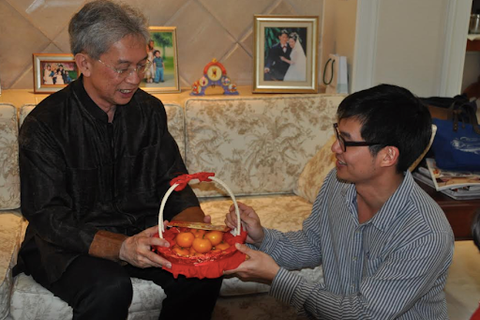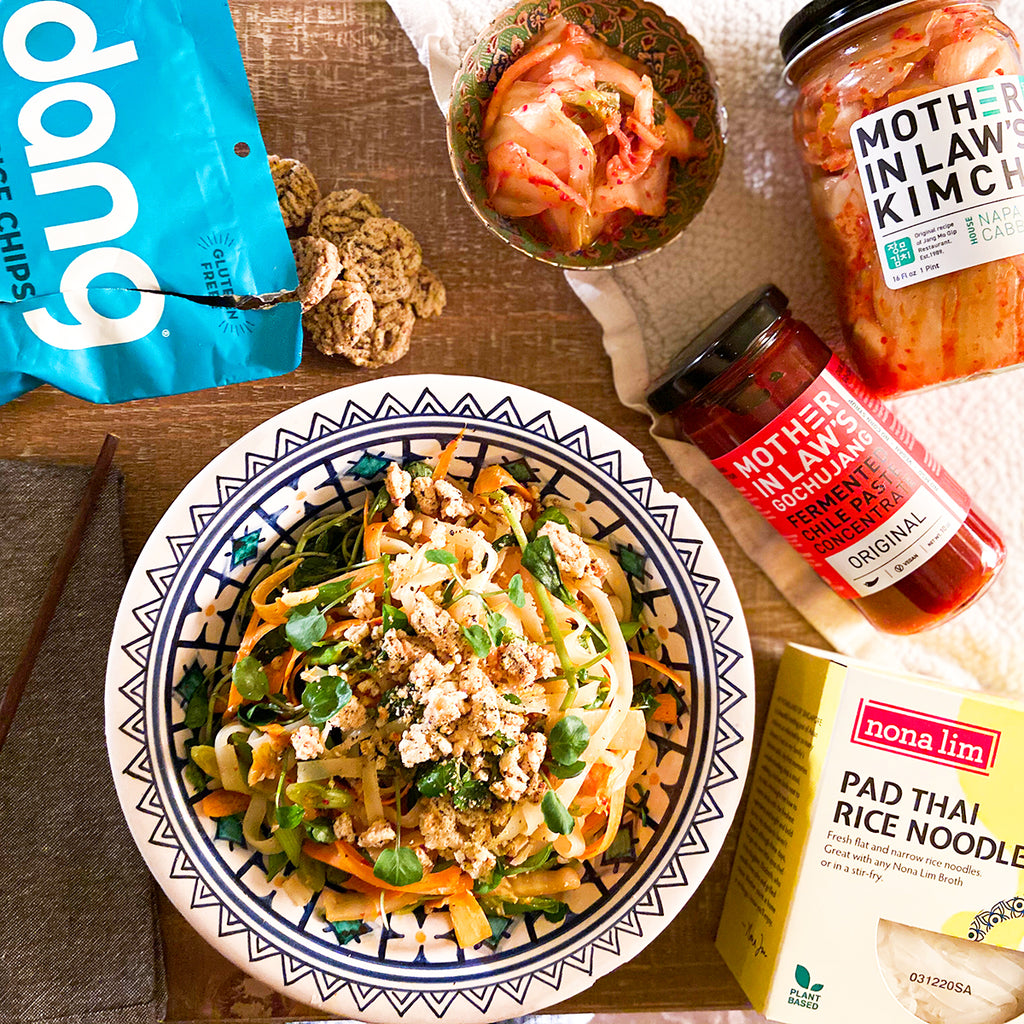As the name suggests, Lunar New Year (aka Chinese New Year or Spring Festival) marks the beginning of a new year in Asian culture. And we’re celebrating with our food family— Dang Foods and Nona Lim! Meet founders Lauryn Chun, Vincent Kitirattragarn, and Nona Lim and learn about their Lunar New Year traditions, from dumpling rolling parties to receiving ang pow! Plus, score a Kimchi Crunch Noodle Salad recipe, perfect for serving up at your dinner table during the 15-day holiday and beyond. Sweet and crunchy with a hint of sour, this recipe combines products from all three brands for extra yum.
Read the full Q&A below:
Okay, first thing's first: Chinese New Year, Spring Festival, or Lunar New Year? Do you have a preference?
Vincent, Dang Foods: We grew up calling it Chinese New Year (I'm Thai-Chinese American), but lately have been calling it Lunar New Year since it's more inclusive of other countries in East/Southeast Asia that celebrate it.
Lauryn, Mother-in-Law’s Kimchi: Lunar New Year, please!
Nona, Nona Lim: Chinese New Year.
This two week period is a culturally-rich holiday full of traditions. How did you celebrate Lunar New Year as a kid? Did you wear specific clothing, eat special foods, or practice certain customs?
VK: We do a few things:
1) Wear red! Red is a lucky color associated with wealth and prosperity, so rock your red.
2) Make dumplings! Dumplings look like little bags of money, and making them each year with family is one thing I look forward to. It's a way to pass on traditions and recipes between generations.
3) Give money! Traditionally we give little red envelopes with money inside called ang pao (see a trend here?). It's a way to transfer wealth from old to young and teach children about the value of savings. Sometimes we give mandarins as well as they're lucky.

LC: Yes, I wore my traditional Korean Dress (picture of me as a kid 6 years old from the cookbook) and we would bow to our elders to receive “lucky” money for the upcoming year. The bowing is specifically a deep, long bow called saebae and I’d practice it to get it right in order to receive New Year’s money or “lucky money” from my relatives and elders. This money is given by parents to their younger children and relatives, from older children to their parents and relatives, and from grandparents to their grandsons and granddaughters. I remember eating Teokgook (soup with sliced rice cakes). It’s Korean custom to celebrate another year, similar to a birthday, by finishing a bowl of this soup which was pretty exciting as a kid.

NL: For our reunion dinner on Chinese New Year’s Eve our family would usually have a steamboat (aka hot pot) dinner, where there would be an array of meats, seafood and vegetables which were cooked by dipping into hot broth. Chinese New Year was the only time of the year when our home would have lots of goodies and treats, like delectable new year cookies and candies, fragrant barbequed pork slices, and soft drinks. Other traditions include receiving a new set of pajamas and two to three sets of new clothes to wear specifically on the first three days of the New Year, which were spent visiting relatives and receiving ang pows (good luck red packets filled with money).
How do you celebrate as an adult? Do you have any new traditions in the works?
VK: I throw a large dumpling-rolling party and invite our community to join us in rolling hundreds of dumplings. We have traditional pork and veggie dumplings, and introduce an experimental one each year. Last year's cheesesteak dumplings were a big hit!

LC: My husband and I started a Lunar New Year tradition when we first met ten years ago. We host friends at our annual Lunar New Year party where we enjoy dumpling soup with rice cakes (Mandu Teokgook). We host the party every year on the first Sunday, and we’re excited that 2020 falls on 1/26 which is NOT a Super Bowl Sunday. Super Bowl Sundays seem to coincide with Lunar New Year, haha.
NL: When I was working in London, I would host a Chinese New Year dinner and invite friends over. We usually had steamboat as well, along with lots of other dishes. Over time as life got busy, I haven’t been able to celebrate the holiday as much. I do have a young daughter now and she receives ang pows for the New Year. We have also taken her back to Singapore to visit family for the Chinese New Year holiday.

2020 is the Year of the Rat. What does this mean to you?
VK: There's a 12 year cycle, and each time your zodiac sign comes back around, it's a huge deal. I'm a rat, my partner is a rat, and we're expecting a baby rat in mid 2020...I guess you could call us the rat pack. The rat came in first in the "great race" - one of the oldest fables in the world about how the Chinese zodiac animals got their order. I won't spoil it for you but rats are known for being hard working, industrious, and intelligent which plays into how they got to #1.
LC: Not much.
NL: It doesn’t mean as much to me. I was born in the Year of the Tiger… so that’s a bigger year for me. =)

How is this holiday celebrated in the United States versus in Asia?
VK: To be honest, I haven't celebrated in Asia, but I hear it's many magnitudes bigger. Imagine millions of city-dwellers taking trains back to their home villages and that's a fraction of what happens during that week. It's a weeklong celebration with parades, fireworks, and tons of eating - I cannot wait to celebrate over in Asia sometime soon.
LC: In Korea, there’s a much bigger traditional celebration that’s a week long and families travel in observance vs. in the U.S., the celebration is much smaller.
NL: In the U.S., Chinese New Year celebrations are more subdued, as the holiday isn’t a national holiday and is generally only celebrated within some Asian communities. Some cities, like San Francisco actually recognize it as a public holiday for school kids; but for most of us it feels like a regular day. Depending on where you are in Asia (not all Asian countries celebrate Chinese New Year, which is also known as Lunar New Year) celebrations can stretch up to 15 days!
Recipe: Kimchi Crunch Noodle Salad

Ingredients
Salad
- 1 5½ oz packet Nona Lim Pad Thai noodles, cooked, rinsed under cold water and drained
- 1 small carrot, julienned
- 3 scallions, chopped into ½ inch pieces
- ½ cup watercress, arugula, or other leafy green, rinsed
- ½ cup Dang’s Savory Seaweed Sticky-Rice Chips or Original Sticky-Rice Chips, crushed into mixed sized pieces
Dressing
- ¼ teaspoon Mother in Law’s Gochujang paste
- ½ cup Mother in Law’s Napa Cabbage Kimchi, chopped into ½ inch strips
- 1 medium garlic clove, crushed and minced
- 1 inch ginger, grated or minced
- 1 teaspoon soy sauce or tamari
- 1 teaspoon rice vinegar
- 1 teaspoon sesame oil
- 1 teaspoon coconut sugar or cane sugar
Instructions
- Place Nona Lim Pad Thai noodles in boiling water for 25-30 seconds until cooked (as per packet instructions). Scoop 1 tablespoon of boiling noodle water and set aside. Strain noodles and rinse under ice cold water. Set aside.
- Mix Mother in Law’s Gochujang paste into reserved noodle water and mix until paste loses clumps. Should be relatively smooth.
- Beat crushed garlic, ginger, soy sauce or tamari, rice vinegar, sesame oil, and sugar into gochujang paste mixture. Add sugar and mix well.
- Add Nona Lim noodles and carrot into dressing and toss until noodles are completely coated. If not enough dressing, add ¼ teaspoon of sesame oil.
- Toss with watercress or other greens.
- Top salad with ½ of crushed Dang crumbles, keep reserve aside to sprinkle on salad while eating to maintain texture!


